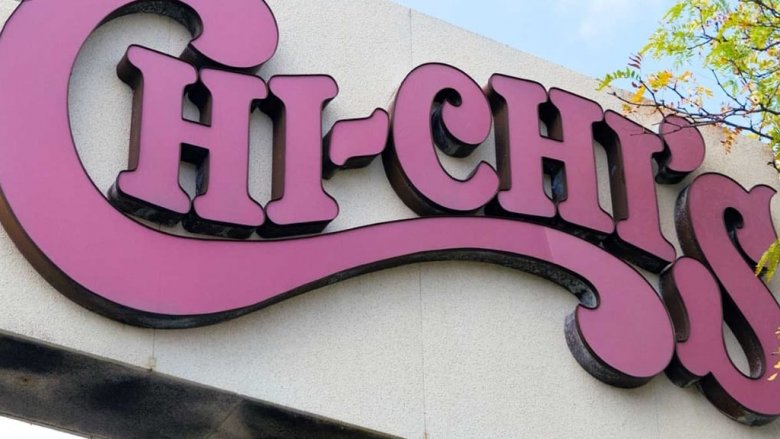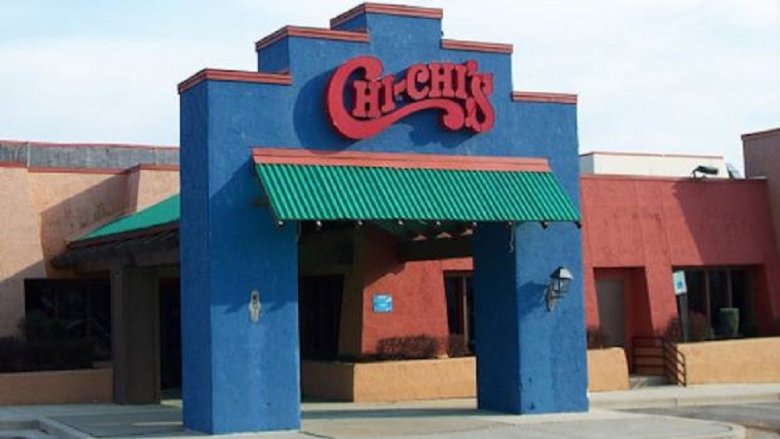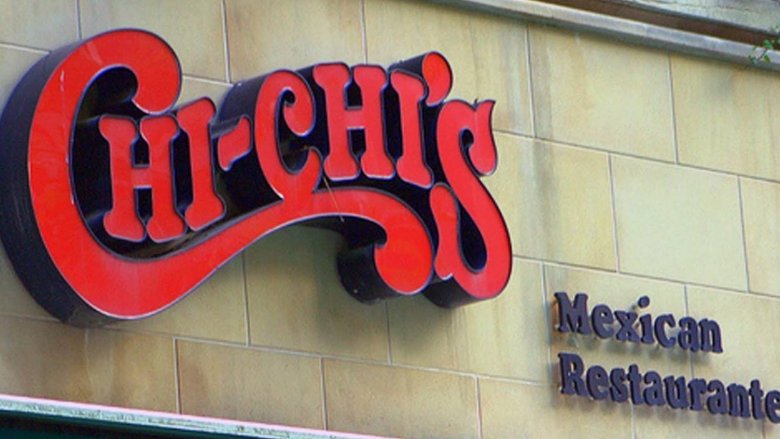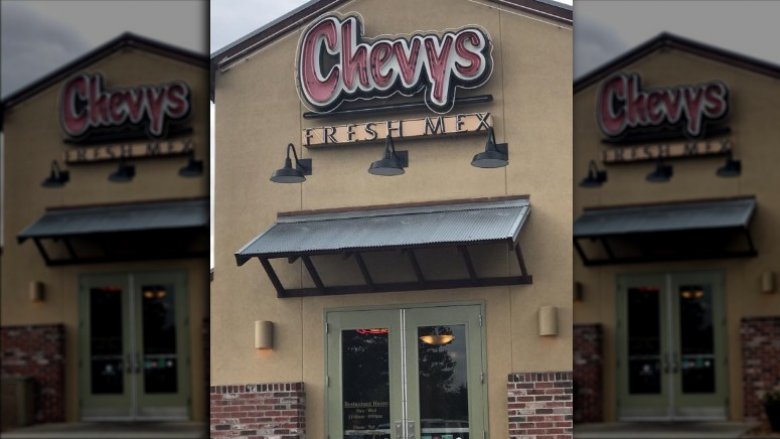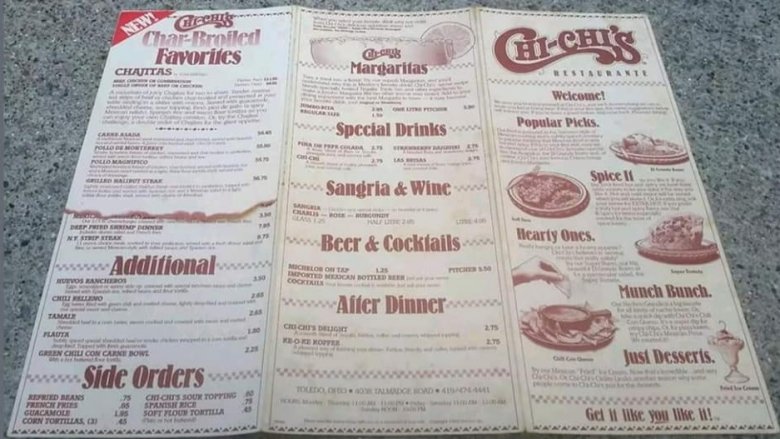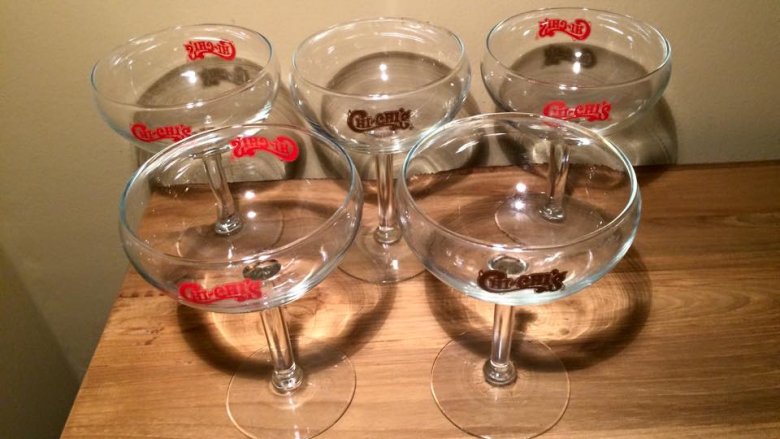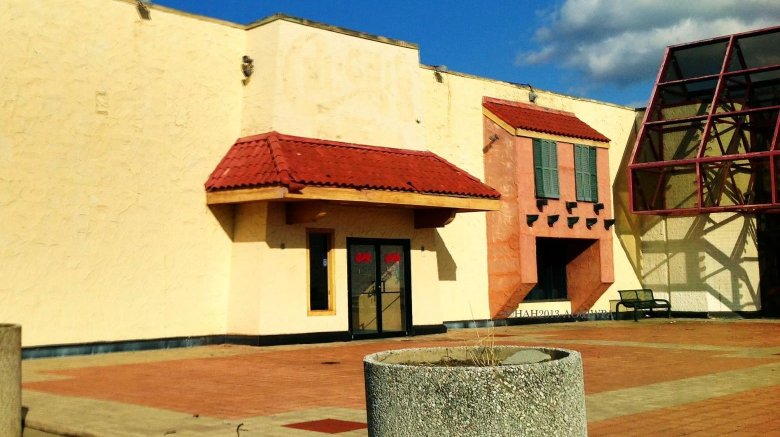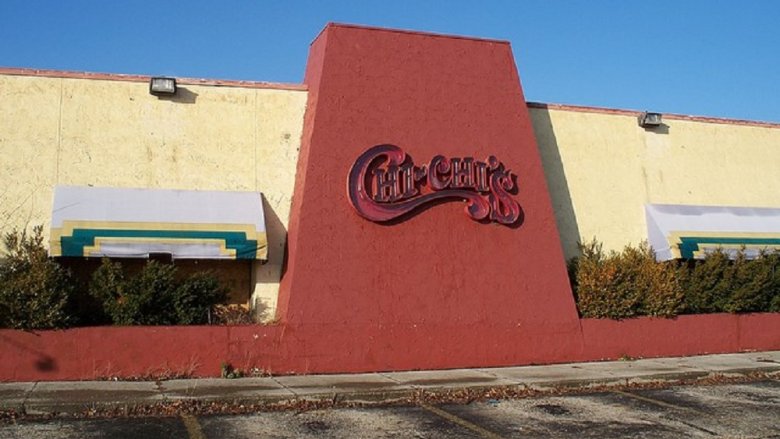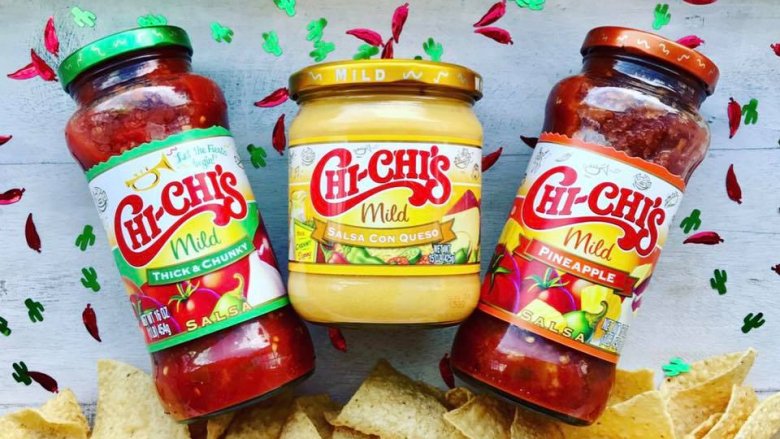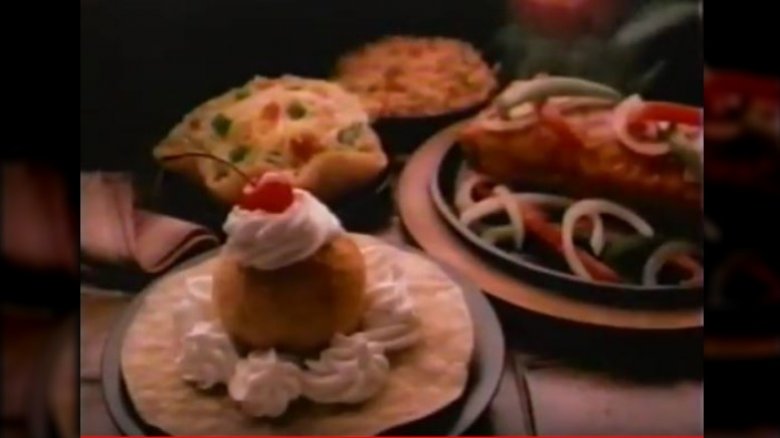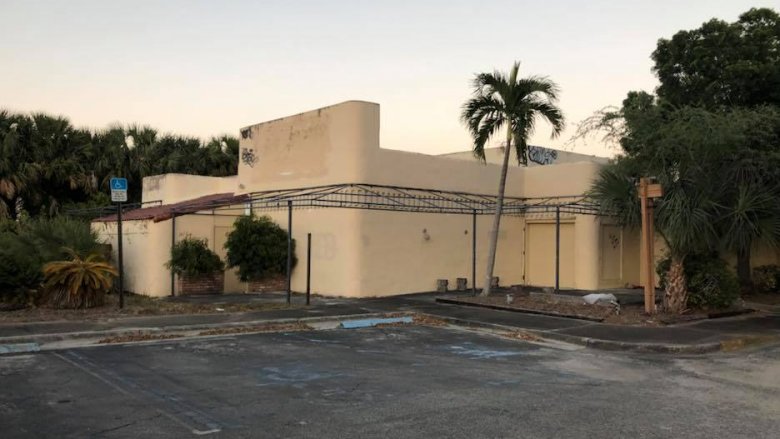Why You Don't See Chi-Chi's Restaurants In America Anymore
Oh, Chi-Chi's. Perhaps the cheesiest pseudo-Mexican restaurant chain ever, and we're not just talking about the queso. This restaurant chain began in Minnesota, of all places, and in the mid-70s, of all time periods, both of which make perfect sense in the context of its almost hilariously over-the-top inauthenticity. Started by two guys by the names of McDermott and McGee, Chi-Chi's was supposedly named after Mrs. McDermott — although history does not record her reaction upon learning that the word is also a rather rude Mexican slang term for, ahem, hooters (a restaurant name that was not yet in use at that time).
Although Chi-Chi's itself is long gone in the United States, vanished in a perfect storm of financial mess and food poisoning, it has left behind it quite a legacy. Not only can we still view a selection of painfully dated commercials complete with the tackiest of uniforms and the fakest of accents, but there's even Chi-Chi's, the movie! Ok, not exactly, but the 1999 indie film Los Enchiladas was inspired by comedian Mitch Hedberg's real life experience working at a Chi-Chi's. So come on, open up a bag of chips (Chi-Chi's, of course) and a jar of salsa (ditto), and get ready to celebrate the silliness that was Chi-Chi's — and figure out why the heck they disappeared.
Chi-Chi's wasn't so popular outside of the Midwest
The businessmen who dreamed up Chi-Chi's actually had a pretty solid idea in the beginning — they were in Minnesota, in the 1970s, and Mexican food options were pretty nonexistent. Even Taco Bell hadn't gone nationwide at that point. These entrepreneurs felt the time was right for a sit-down Mexican restaurant in the Midwest. Well, their profits went way beyond their expectations — at $2 million, they took in five times their projected revenue that first year in business.
Naturally, success like that does not escape the eyes of big money investors. Within a few years, the franchise operation was bought out, and control was given to one of the bigwigs at Kentucky Fried Chicken. While he moved company headquarters from Minneapolis to Louisville, the chain's expansion in the '70s and early '80s remained centered on the Midwest.
The Midwestern restaurants remained quite successful, mostly due to the fact that they faced little or no competition or expectations when it came to Mexican food. When Chi-Chi's tried expanding into other markets like New York or Miami, places where people's taste buds were more refined, they didn't catch on. Their failures in Texas, California, and New Mexico were, perhaps, to be expected, but when Chi-Chi's failed to take hold even in New England or the deep South, it started to seem like the fiesta might be starting to wind down.
Chi-Chi's grew too quickly
Ironically, Chi-Chi's success was the very thing (well, one of them) that set the stage for its subsequent doom. In the early '80's, Chi-Chi's was one of the hottest chains going, opening 45 new restaurants within a two-year period between 1981 and 1983. Frequently, these new restaurants would see profits of up to $80,000 per week, which was big stuff for the early '80s, as was the annual overall profit of over $9 million. By 1984, Chi-Chi's net income was over $16 mil, and by 1986 there were more than 200 Chi-Chi's restaurants throughout the nation. And this was pretty much as good as it got.
Even as they were at their peak, their profits were starting to slide. It seems that the larger (10,000-12,000 square foot) restaurants they were opening during their frenzied early '80s growth spurt were just too large to operate at a profit. Too-rapid growth also contributed to numerous problems at the corporate level, with an insanely high 80 percent management turnover rate leading to inconsistencies in food and service that did the chain no favors.
Chi-Chi's success spawned competition
While Chi-Chi's might have introduced Mexican food to certain markets, at least in the Midwest, it also opened the door for other Mexican restaurant chains such as El Torito, Casa Gallardo, and On the Border, all of which would soon be expanding to compete with Chi-Chi's throughout the U.S.
What's more, Mexican fast food was also becoming a thing what with the rise of Taco Bell, which would pose itself as a serious Chi-Chi's competitor in the 1990s with its purchase of casual dining chain Chevy's Fresh Mex. Even McDonald's would get into the Mexican food game, adding breakfast burritos and (for a limited time) chicken fajitas to their menus. Then came the new millennium, and with it the rise of fast casual, with restaurants like Baja Fresh, Qdoba, and the big dog Chipotle creating a market for the budget burrito.
Non-Mexican casual dining restaurants would also cut into Chi-Chi's target audience, as diners wishing for a fun but not too fancy evening out could, by the '90s, choose from other options including Olive Garden, Macaroni Grill, and Chili's. This last-named even offered a southwestern-ish kind of menu, and could actually boast Texan (as opposed to Minnesotan) roots.
Chi-Chi's wasn't authentic Mexican food
As the population of Mexican immigrants continued to grow and expand throughout the United States in the latter part of the 20th century, these new immigrants brought with them their food traditions. What this meant, particularly for those of us not living in one of the southwestern border states, was that we were finally able to taste Mexican food as it was meant to be. And we found, much to our surprise, that it was nothing whatsoever like the food that Chi-Chi's had been dishing up.
With real Mexican food, cheese is cotija, not cheddar or (horrors!) processed. Beans are fresh, not from a can. Sour cream does not smother everything. Not every type of food can or should be deep fried (no, not even ice cream). Chimichangas aren't even a thing. And who even knows what a Chajita is, apart from a former Chi-Chi's employee with a very long memory? As discerning diners came to know Mexican cuisine in all its glorious diversity, from fine dining to bodegas, carnicerias and even taco trucks, the days of the El Grande Burro were drawing to a close.
Chi-Chi's lost clientele when the drinking laws changed
One of the things Chi-Chi's was known for, back in the day, was perhaps something they'd have preferred not to publicize. According to anecdotal evidence unearthed on the internet (you can run, but you can't hide, ancient anecdotes!), certain Chi-Chi's were popular among teenage drinkers. Not all that surprising, when you think about it, since a cheap pitcher of strawberry margaritas is obviously going to appeal to a high school crowd more than, say, a selection of single malt scotches. What you need to keep in mind, however, is that in Chi-Chi's earlier years, a certain amount of teenage drinking was actually legal. Yes, believe it or not, boomers and early Gen X-ers were legally able to imbibe at age 18, right up until 1984 when the National Minimum Drinking Age Act raised the drinking age to 21.
Coincidentally (or not), Chi-Chi's profits took a tumble after that year. The higher drinking age cut out the 18-20 crowd, at least those not possessed of convincing fake IDs. Needless to say, this eliminated not only high schoolers, but a good chunk of the college crowd. Not to mention, the Reagan-era "Just Say No" philosophy was beginning to affect drinking habits in general, with stiffer state laws being enacted in order to curb drunk driving and control bar happy hours. The resulting drop in public alcohol consumption nationwide affected the restaurant industry as a whole, and Chi-Chi's restaurant profits were definitely feeling the hangover.
Chi-Chi's went bankrupt, then were bought out by Outback
After Chi-Chi's struggles in the '80s, they were bought out by Foodmaker, Inc., the fast food conglomerate that owned Jack-in-the-Box. Things started looking up again for a bit, profit-wise, but the menu certainly didn't improve — any original menu items even remotely resembling Mexican cuisine were replaced by Tex-Mex and "Mexicanized" American items like pizza, pasta, and stir-fry. Sales soon started to slip again, and restaurants kept on closing. From a 1986 high of 200 restaurants, Chi-Chi's was down to 150 and still dropping by the end of the '90s. In 2002, Chi-Chi's debt-ridden parent corporation Prandium declared Chapter 11 bankruptcy
While Prandium would emerge intact from their own bankruptcy proceedings the next year, Chi-Chi's themselves would themselves file Chapter 11 in 2003, and for them there would be no recovery. By 2004, Outback Steakhouse would purchase 76 remaining Chi-Chi's restaurants, complete with all furniture and fixtures, with the stated intent to convert at least some of the properties to its own brand of restaurants. Some of these closed Chi-Chi's were not repurposed as Outbacks, however. A number of them were eventually sold to be demolished or used to house other businesses. Still other old Chi-Chi's, creepily, are still haunting the landscape, long abandoned but perhaps still filled with the ghosts of sombrero-wearing, margarita-drinking revelers from times gone by.
The biggest hepatitis A outbreak ever to hit the US happened at Chi-Chi's
While many businesses not only survive but thrive after bankruptcy, Chi-Chi's was dealt a fatal blow (literally, for several customers as well as the company) by something totally unexpected — a massive hepatitis outbreak. Health department investigations traced the source of this October 2003 outbreak to the Chi-Chi's at the Beaver Valley Mall in Monaca, Pennsylvania. While they originally suspected unsafe food handling practices, the source was eventually determined to be green onions used as an ingredient in dishes including salsa.
By the time the outbreak was over, it had made 660 people, including 13 restaurant employees, sick. What's worse, four people had actually died. Over 9,000 people exposed to the hepatitis had needed to be inoculated against the disease. Even though Chi-Chi's had declared bankruptcy prior to the hepatitis outbreak, the bankruptcy court nevertheless modified the order to allow hepatitis victims to proceed with lawsuits against the chain. Among the payouts Chi-Chi's subsequently made were an $800,000 class action settlement paid out to those who'd needed to be immunized after hepatitis exposure and a $6.25 million settlement to a man whose hepatitis had caused him to require a liver transplant. Before Chi-Chi's folded, they'd had to shell out at least $40 million in hepatitis-related settlement payouts. They, in turn, sued the green onion supplier, but were unsuccessful. By that point it was too late anyway, since Chi-Chi's had long since said hasta la vista, baby.
Chi-Chi's restaurants still exist overseas
While Chi-Chi's restaurants are completely absent from America, they do still exist in a few locations overseas. It would seem, however, that Chi-Chi's Asian and North African locations have now gone the way of their western hemisphere counterparts. Both the Indonesia and Kuwait locations have long been social media silent (never a good sign), while the Abu Dhabi Chi-Chi's, which had been located in the Le Meridien hotel, now appears to have been replaced by different dining options.
An article published in 2014 on global business website RetailDetail makes mention of Chi-Chi's restaurants in Germany and China, and those seemed to still be in operation as of 2016. Chi-Chi's are still going strong in the Benelux area, where there seem to be several restaurants still in operation. There is also at least one Austrian Chi-Chi's, located in Vienna. And good news! It looks like fried ice cream remains on the menu, along with strawberry margaritas (not to mention, most of Europe's got a much lower drinking age). If you're still craving Chi-Chi's, you won't need a time machine, just a plane ticket.
Chi-Chi's went back into business marketing products
If Chi-Chi's logo looks familiar to you despite the fact that you've never eaten in any of their restaurants, it's because Chi-Chi's is actually still around, just in a different way. They are even continuing to serve up chips and salsa and margaritas. No, not at a table, you've got to supply your own there. Also your own bowls, glasses, salt and ice for the margaritas, and just about everything else in the way of equipment and ambience. Chi-Chi's today is strictly about the products, and a limited number of these at that. Rebranded as a producer of retail food items, their current line includes a dozen different salsas, a queso dip, six different varieties of tortilla chips, various sizes of flour and corn tortillas, several types of seasoning, corn cake mix, and chopped green chiles.
Chi-Chi's pre-mixed cocktails are owned by a different outfit, the Sazerac Company. These drinks are available in 1.75 liter handles (there's your pitcher right there), and aren't limited to margaritas alone. Margaritas come in six different kinds: original, strawberry, peach, ruby red, golden and skinny margaritas. There is also a Chi-Chi's-branded Mojito, Long Island iced tea (regular and skinny), pina colada, and even dessert drinks: Mexican Mudslide, White Russian, orange cream, and chocolate malt. Pick up a few of those, some Chi-Chi's chips and salsa, maybe some queso, and there you have it, DIY happy hour. Just add a tacky sombrero, and you're all set to get your fiesta on.
Chi-Chi's secret recipes were supposedly stolen by an ex-employee
If you're jonesing for some Chi-Chi's food that goes beyond chips and salsa or corn cakes, and you can't afford a plane ticket to Europe, you can always try Googling the old recipes. There are a plethora of Chi-Chi's copycat creations out there, including knockoff nachos grande, chimichangas and salsa verde chicken kabobs. The new Chi-Chi's website even has a few recipes of its own, although these all appear to have been created to utilize their products rather than recreate any of the dishes from their glory days as a restaurant. Still, who'd say no to a taco cone or a nacho burger? The PBJ and banana quesadillas look a little dubious, though, unless you're a dedicated Elvis impersonator.
You may, just may, be able to get your hands on a few of the genuine Chi-Chi's recipes if one urban legend turns out to have a core of truth. As the story goes, a disgruntled ex Chi-Chi's employee stole some of the top-secret recipes on his or her way out the door. These purportedly once-classified documents, were published in 2010 in several local newspapers including the Springfield, Illinois State-Journal Register and the Fall River, Massachusetts Herald News. Included among them were recipes for chili con queso, mild salsa, and seafood nachos. When it comes to a recipe (real, fake, or otherwise) for the mysterious Chajita, though, your guess is as good as ours.
Chi-Chi's is gone, but definitely not forgotten
Chi-Chi's has been closed for a decade and a half now in the United States and Canada, but some people still don't want to let it go. The much-loved restaurant chain has an active Facebook tribute group, as well as several groups devoted to petitioning the universe, in general, to "Bring Back Chi-Chi's!" There are also a few different groups and pages for Chi-Chi's restaurant worker alumni. Various websites, blog posts, and a surprising number of videos have been devoted to documenting or attempting to urban spelunk the remaining abandoned Chi-Chi's buildings. You can even go on eBay and shop for vintage Chi-Chi's collectibles.
The one thing that does not yet seem to have come to pass, however, is a tour group organized to visit all of the remaining Chi-Chi's restaurants in Europe. Anyone interested in taking on this organizing project? We're guessing there would be some interest.
